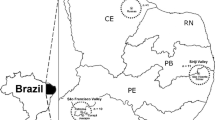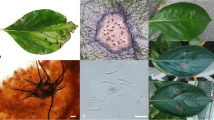Abstract
A newSclerotinia, previously reported asS. intermedia from Japan, is described asSclerotinia nivalis on the morphological basis of the sclerotial anamorph and teleomorph produced in culture. The characters assigning this species to the genusSclerotinia are the tuberoid sclerotia superficially produced on suscepts, the small sclerotia produced on aerial mycelium in culture, the interhyphal spaces in medullary tissue of sclerotia, and the globose cells constructing the ectal excipulum of apothecia. It is distinguishable fromS. sclerotiorum, S. minor, andS. trifoliorum by the intermediate sized sclerotia in culture, binucleate ascospores, the molecular mass of major proteins of sclerotia, and the patterns of esterase isozymes in sclerotial extracts. AlthoughS. nivalis causes snow mold of various dicots, it is a mesophile having an optimum temperature for mycelial growth of around 20°C. It attacks edible burdock(Arctium lappa), Chryhsanthemum morifolium, Ambrosia elatior, carrot(Daucus carota), Angelica acutiloba, Ajuga reptans, andPlantago lanceolata.
Similar content being viewed by others
Literature cited
Arseniuk, E. and Macewicz, J. 1992. Scanning electron microscopy of sclerotia ofSclerotinia trifoliorum Erikss, and related species. J. Phytopathology141: 275–284.
Bennel, A. P., Christopher, P. and Walting, R. 1978. Technique for routine anatomical studies of dried and fresh basidiomes, using plastic embedding and dichromatic staining. Trans. Br. Mycol. Soc.71: 512–515.
Booth, C. 1971.Micronectriella nivalis. Descriptions of pathogenic fungi and bacteria. No. 309. Commonw. Mycol. Inst. Assoc. Appl. Biologists, Kew, Surrey, England.
Bradford, M. M. 1976. A rapid and sensitive method for the quantitation of microgram quantities of protein utilizing the principle of protein-dye binding. Anal. Biochem.72: 248–254.
Cook, R. J. and Bruehl, G. W. 1968. Ecology and possible significance of perithecia ofCalonectria nivalis in the Pacific Northwest. Phytopathology58: 702–703.
Henderson, S. A. and Lu, B. C. 1968. The use of haematoxylin for squash preparations of chromosomes. Stain Technology43: 233–236.
Jensen, W. A. 1962. Botanical histochemistry, pp. 88–90. W. H. Freeman, San Fransisco.
Keay, M. A. 1939. A study of certain species ofSclerotinia. Ann. Appl. Biol.26: 227–246.
Kohn, L. M. 1979. A monographic revision of the genusSclerotinia. Mycotaxon9: 365–444.
Kohn, L. M., Petsche, D. M., Bailey, S. R., Novak, L. A. and Anderson, J. B. 1988. Restriction fragment length polymorphism in nuclear and mitochondrial DNA ofSclerotinia species. Phytopathology78: 1047–1051.
Lu, B. C. 1962. A new fixative and improved propiono-carmine squash technique for staining fungal nuclei. Can. J. Bot.40: 843–847.
Miyajima, K. and Saito, I. 1984. Occurrence ofFusarium nivale on wheat and barley during growing season. Ann. Phytopathol. Soc. Japan50: 97. (Abstract in Japanese.)
Narita, T. 1980. Crop diseases in Hokkaido Sapporo, pp. 295–296. Hokkaido Plant Protection Society, Sapporo. (In Japanese.)
Purdy, L. H. 1955. A broader concept of the speciesSclerotinia sclerotiorum based on variability. Phytopathology45: 421–427.
Saito, I. 1977. Studies on the maturation and germination of sclerotia ofSclerotinia sclerotiorum (Lib.) de Bary, a causal fungus of bean stem rot. Rep. Hokkaido Prefec. Agric. Exp. Stn.26: 1–106.
Saito, I. 1985. Re-examination of aSclerotinia from Japan reported previously asSclerotinia intermedia Lamsey. 3rd Inter. Mycol. Congr., Tokyo, Japan, August 28–September 3, p. 617.
Sass, J. E. 1951. Botanical microtechnique, pp. 14–21. The Iowa State College Press, Ames, Iowa.
Sugimoto, T., Miura, T. and Kobayashi, J. 1962. Studies on the sclerotial rot of carrot roots. Mem. Fac. Agric. Hokkaido Univ.7: 121–129.
Tariq, V.-N., Gutteridge, C. S. and Jeffries, P. 1985. Comparative studies of cultural and biochemical characteristics used for distinguishing species withinSclerotinia. Trans. Br. Mycol. Soc.84: 381–397.
Tochinai, Y. and Sugimoto, T. 1958. Studies on the sclerotial disease ofArtemisia maritima L. Mem. Fac. Agric. Hokkaido Univ.3: 149–153.
Wilson, A. D. 1992. A versatile Giemsa protocol for permanent nuclear staining of fungi. Mycologia84: 585–588.
Author information
Authors and Affiliations
About this article
Cite this article
Saito, I. Sclerotinia nivalis, sp. nov., the pathogen of snow mold of herbaceous dicots in Northern Japan. Mycoscience 38, 227–236 (1997). https://doi.org/10.1007/BF02460857
Accepted:
Issue Date:
DOI: https://doi.org/10.1007/BF02460857




